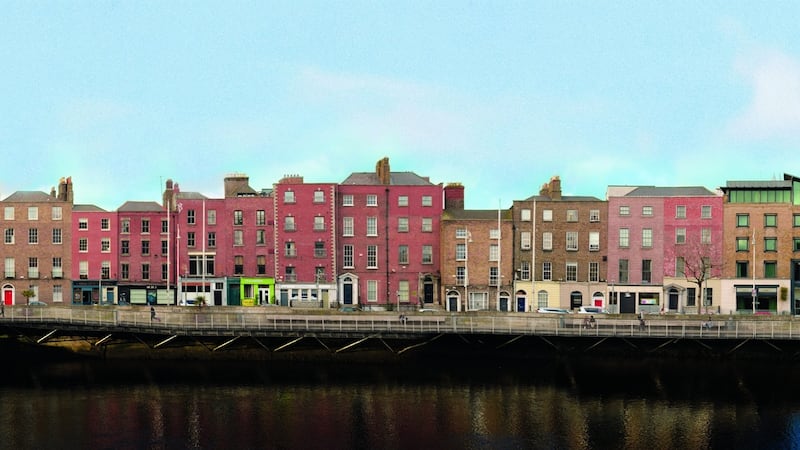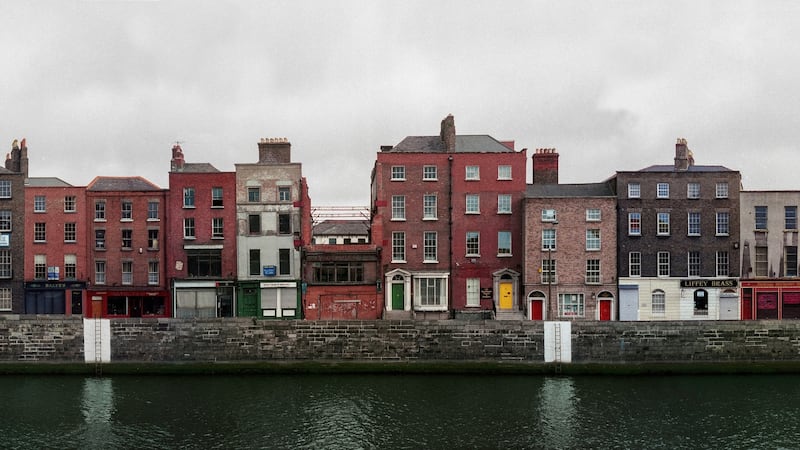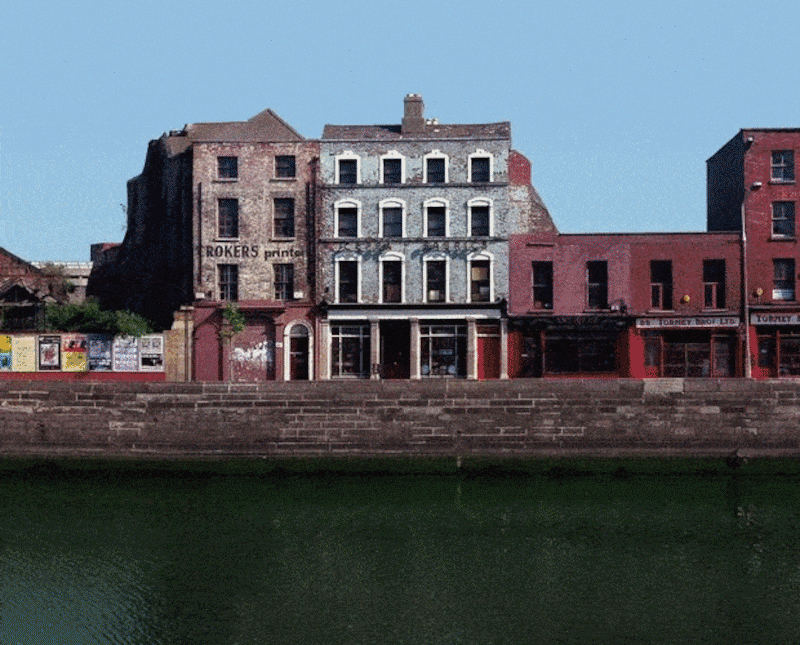Dublin Before the Tiger is a long-term study of the inner city from 1982 to 1992 by German photographer David Jazay.
As a visitor to Dublin in those years, Jazay was acutely aware that the city was changing fast, and he set out to document premises under immediate threat of demolition.
He felt – rightly as it turned out – that this “poor but lively inner city” would lose much of its local business culture within a few years.
Jazay says: “This whole microcosm would irrevocably change a few years later, in the boom years of the Celtic Tiger.”
*****
David Jazay’s 1991 picture of Dublin’s Lower Ormond Quay in dereliction and decay is a portrait of the city at her most abject: the battered, broken-down old town written about often at the time.
It seemed nobody was listening back then. Jazay, on the other hand, was looking keenly at what most of us couldn’t yet see, grown accustomed as we had to buildings vanishing in the night, and rubbing our eyes until we couldn’t remember what had been standing there in the days before.
Much of Dublin’s inner city looked like the rest of Europe after the second World War. Our damage had not been caused by bombs, however, but by the self-inflicted wounds of large-scale property speculation and municipal road-widening plans that cast a blight over everything they touched.
It is hard to believe now that Jazay captured this forlorn image in 1991, when Dublin was European City of Culture: at the very moment the cock began to crow – and the tiger to awaken – just across the river from here in Temple Bar.
Jazay, a German photographer and award-winning filmmaker, first came to Dublin in 1982 as a 16-year-old exchange student at Newpark Comprehensive School. Soon he was compiling an archive, creating a unique time capsule of the dilapidated Dublin he liked to explore on Sunday mornings. “I felt the madness, and obligation, to capture a beautiful but derelict cityscape that was vanishing before my eyes,” he says.
Jazay used his father’s Rolleiflex medium-format camera, shooting on low-speed film that captured the minutest of details, even at a range of 50m. The images kept piling up, as he returned to Dublin time and again over the next decade to record the last corner shops, antique furniture stores and auction houses along the Liffey, as well as the people living and working there.
Not until 2014, however, would sufficient computer image-processing power exist to turn his collection into high-resolution panoramas that can be printed two metres high without sacrificing detail. His image of Lower Ormond Quay is digitally stitched together from six individual negatives and depicts “ a ragged jumble of antique shops, greasy spoons and car repair places”.
Grand plans
How the mighty had fallen. The first of the broad quays on the north side of the River Liffey, Ormond Quay was laid out by Sir Humphrey Jervis in the 1680s as part of one of the grandest dreams the city of Dublin ever had.
Named in honour of James Butler, the First Duke of Ormond, who as Lord Lieutenant was de facto ruler of Ireland, it immediately became the capital’s most fashionable suburb.
When, following the Restoration, Ormond returned to Dublin from exile in Europe with Charles II, he set about beautifying and ornamenting the capital in the continental manner. He laid out Phoenix Park, built the Royal Hospital at Kilmainham and encouraged the development of Smithfield and St Stephen’s Green. He also instigated the trend for building houses facing the river.

The new Essex Bridge (now Grattan Bridge), seen on the left of the photograph, had at last opened up Capel Street and the rest of the north bank as far as O’Connell Street for development.
Jervis’s original plans showed the backs of the houses and warehouses turned to the river, in the traditional medieval manner.
Ormond persuaded Jervis to narrow the river by building a stone quay in front as a fashionable residential parade with associated commercial uses. His suggestion, which could hardly be ignored, was of immense importance to the future development of Dublin and inspired the city’s entire system of quays.
Ormond Quay remained fashionable until the end of the 18th century, when the old custom house, which had stood on the opposite quay, was replaced by James Gandon’s masterpiece downriver. O’Connell Bridge was soon built and within a few decades Ormond Quay’s grandeur was eclipsed.
The decline was gradual enough during the 19th century. The Dublin Pictorial Guide & Directory of 1850 lists picture-framers, law stationers, dressmakers, gunsmiths, solicitors, auctioneers, accountants, booksellers and watch makers based here. But the fashionable had long since departed.
Threat of redevelopment
Physical decay accelerated during the 20th century to the point where it is amazing that any buildings managed to survive. The enemy was not so much dereliction, common throughout the inner city in the 1970s and 1980s, but repeated threats to demolish the block for comprehensive redevelopment.
The first of these occurred in 1940, when the Dublin Sketch Development Plan, drawn up by Sir Patrick Abercrombie, Sydney A Kelly and Manning Robertson, proposed a gargantuan new Metropolitan Cathedral on a levelled riverside site stretching from Lower Ormond Quay to Upper Abbey Street and from Capel Street to Lower Liffey Street. “The property involved, while considerable, is of little value,” the authors wrote.

Next came the road engineers’ plan to widen both the north and south quays to a uniform 60ft (as at Wood Quay), which would have turned the river into a watery “central median” between the up and down routes for cars commuting to and from the suburbs. This threat, which hung over the quays for decades, meant there was simply no demand for buildings like these.
Then, following recommendations made by German traffic expert Prof Karlheinz Schaechterle in 1968, CIE commissioned US architects Skidmore Owings & Merrill to design a grandiose transportation centre for central Dublin, with a southern terminal that would have demolished much of Temple Bar and a northern terminal on Lower Ormond Quay, extending from Swift’s Row to Lower Liffey Street.
That plan was killed shortly before Jazay took his photograph, which lays bare the result of these repeated threats. Powerful state and city policy objectives had directly caused the dereliction we can see – and not only at Ormond Quay – although this city block was targeted to a greater extent than most.
The Architectural Review, a leading international journal, was horrified by what it saw when preparing a special edition on Dublin in November 1974: "While picturesque decay may have its attractions as the subject for a painting, to allow structures to rot as they are doing along the Liffey quays is disastrous, for these riverside buildings are the essential Dublin. Individually unremarkable as works of architecture, collectively they are superb. If they are allowed to disintegrate, the most memorable aspect of the city will be lost."
No trace of Ormond Quay in its 17th century heyday is visible today, although parts of some of its houses survive, concealed from view by later alterations. To imagine it as it originally was, think of canal-side Amsterdam. It must have presented a picturesque scene, with the river in front of the quayside crammed with small sailing vessels, barges and ferries, backed by a terrace of Dutch-style gabled houses of varying heights and widths.
Despite its tumbledown appearance in Jazay’s photograph, Ormond Quay is one of the most intact ranges of 18th century buildings along the River Liffey. That physical heritage has largely been secured for future generations during the past 27 years. All of the historic buildings in the photograph have been included on the Record of Protected Structures.
Lost character
Major new traffic infrastructure – the Port Tunnel (2006) and Santiago Calatrava’s James Joyce Bridge (2003) and Samuel Beckett Bridge (2009) – took heavy goods vehicles off the quays, greatly reducing the pressure on pedestrian users.
At the same time, key features that gave Ormond Quay much of its special character have been lost since 1991. Despite good intentions, the quality of street life has been deadened. The loss of many of the quay’s unique and most convivial uses is grievous and cannot be compensated by ever more anodyne coffee shops.
Nor has McGarry Ní Éanaigh's Liffey Boardwalk (2001), conceived as a generous riverside civic amenity, been an untrammelled success, as anti-social behaviour there has emerged as an issue "broader than the council can handle", as Dublin City Council manager Owen Keegan told this paper last year.
Howley Harrington’s Millennium Bridge has proved successful, greatly relieving congestion on the Ha’penny Bridge. However, the absence of a consistent maintenance programme has meant that its aluminium-bronze leaning rails are regularly tagged with graffiti, while the lamp standards at either end of the bridge are festooned with stickers. This lack of adequate maintenance by the city council extends to the boardwalk where, for whatever reason, entire sections of the handrail are wrapped in plastic.

The infill architecture on Ormond Quay has been of mixed quality. Conservation architects Shaffrey Associates developed a charmingly decorative postmodern apartment building in 1993 at number 28. The infills at numbers 8 and 20-23, the latter a Georgian pastiche of 1994 by Ambrose Kelly & Associates for Cosgrave Brothers, are unfortunate.
Many of the shopfronts are shuttered, while several houses appear vacant and at risk, including the building on the corner of Capel Street, which dates to around 1790 and features in a celebrated view by James Malton.
Even the future of the finest house on the quay, number 10, reputedly designed by Richard Cassels, and once the home of David La Touche, founder of the Irish banking system, may be uncertain, as it has recently been on the market.
Lower Ormond Quay may have turned a corner in recent years, but there is still some way to go before this story can end happily.
Four changes to the north quays
1. Morrison Hotel
When the swish Morrison Hotel first opened in 1999, it caused such a sensation that someone from Sandycove dubbed it a “southside embassy” on the north side. No hotel as grand as this had been built north of the Liffey since the rebuilding of the Gresham on O’Connell Street in the 1920s.
Designed by Douglas Wallace Architects, headed by Hugh Wallace of RTÉ Home of the Year fame, its interiors were by fashion designer John Rocha, whose concept for the project was “black lacquer everywhere”.
And so it was.
The Morrison was developed by one-time pub tsar, the late Hugh O’Regan, and extended during the boom years to incorporate listed Georgian buildings to the west, with a large extension along Great Strand Street to the rear, giving it 145 bedrooms altogether.
In 2012, the entire property was acquired by a Russian billionaire, Elena Baturina, for a knockdown price of “between €20 million and €25 million”, and she commissioned architect and interior designer Nikki O’Donnell, of NODA, to give it a comprehensive makeover. The corner site was previously occupied by the Ormond Printing Company, whose fairly standard 1960s building, relieved by some mosaic work, briefly served as an artists’ retreat from already-overheated Temple Bar, prior to being demolished for the four-star hotel.
2. Bachelors Walk
The most visible of the Liffey quays, due to its location between the Ha’penny Bridge and O’Connell Bridge, Bachelors Walk was left to go to rack and ruin over several decades.
McGrath’s tea warehouse at the corner of Lower Liffey Street as one of the major losses.
In the late 1980s, the entire stretch attracted the attention of Luton-based developer Tom Gilmartin, whose plans to cover it with a shopping centre came with the bizarre idea of locating a city bus station on the roof, which the planners said raised “civic design issues” (to put it mildly).
The entire site later fell into the hands of Liam Carroll, whose Zoe Developments became synonymous with “shoebox flats”, and he declined to engage architectural advice on the spurious basis that “architects are only interested in designing penthouses for fellows with Mercs”.
With the aid of informal advice from Dermot Kelly, then a city planner, Carroll proceeded to build more than 330 apartments on the site, in a Georgian pastiche style – complete with fake chimneys, as there isn’t a fireplace in any of the flats, other than in the older buildings.
Worst of all, the former Dublin United Tramway Company’s headquarters – a rare example of the Egyptian Art Deco style – was demolished to make way for a half-baked “replica” of itself.
3. Mick Wallace’s mall

In 2005, Mick Wallace was six years away from being elected as an Independent TD for Wexford when, wearing his former hat as a builder and property developer, he completed what was then billed as Quartiere Bloom and came to be known as the Italian Quarter.
With a restaurant, cafe, wine bar and even a hookah bar, it was hailed as a “great example of how good, lively urban spaces can be created on a tight scale” by George Ferguson, former president of the Royal Institute of British Architects and one-time mayor of Bristol.
Designed by Terenure-based architect George Morris, its frontage on the quays incorporates the retained facade of an older building, which is cut through at ground level to provide a wider access route from the Millennium Bridge to Mick Wallace’s mall.
Apartments on the upper levels were selling for boom-time prices between ¤480,000 and ¤1.6 million in the final phase, but many have since become short-lets via StayCity, which may be related to recurring problems Wallace was having with his former bankers.
The route through, just six metres wide, is enlivened by an irreverent mural inspired by Leonardo Da Vinci’s Last Supper and leads on through Liam Carroll’s Millennium Walk via the city centre’s first zebra crossing in decades to the Luas Red Line’s Jervis stop.
4. Traffic
Gone are the days when most of the State’s road freight used to trundle up and down the Liffey quays, carried in seemingly endless parades of heavy goods vehicles – juggernauts, in plain language – in what was almost certainly the only example in Europe of a capital city abusing its riverfront in this fashion. The trucks are long since gone, with a few exceptions, thanks to the opening in 2006 of the ¤750 million twin-bore Dublin Port Tunnel, linking the M1/M50 to the port.
As soon as it was finished, Dublin City Council planners pledged that the road space vacated by the trucks would be “reconfigured” for other uses.
It took years to make good on this promise, and then only partially. Spurred by the need to accommodate the Luas Cross City at O’Connell Bridge, private cars were restricted to a single lane in August 2017, on both Bachelors Walk and Aston Quay, and this resulted in a dramatic improvement in bus journey times.
However, almost as soon as the ¤368 million Luas line came into operation last December, bus journey times lengthened once again, and there is as yet no agreement on the Liffey Cycle Route that is supposed to link Phoenix Park with the docklands.
As usual, cyclists come last in the pecking order.











